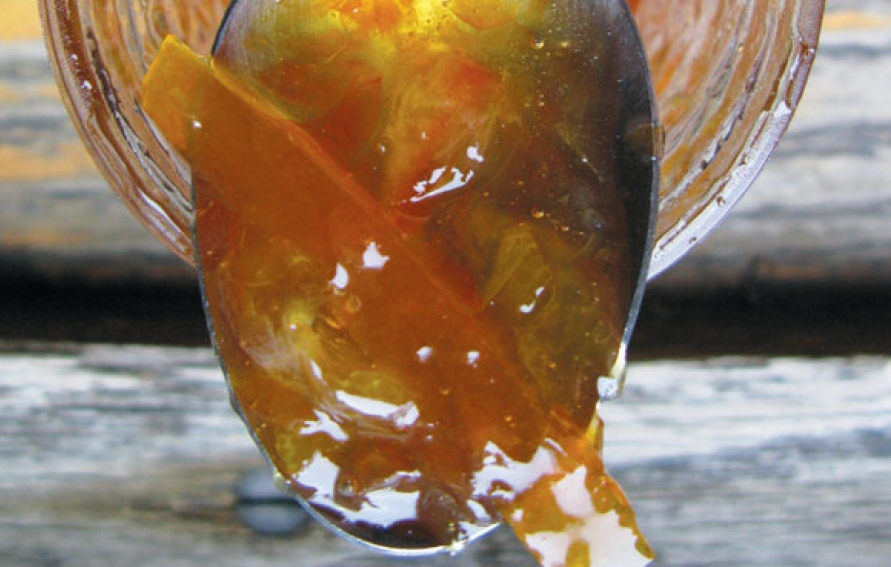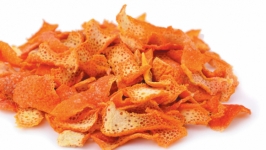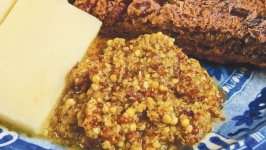Ingredients
- 1 grapefruit (I prefer red)
- 3 oranges (try Blood oranges or Honeybell tangelos)
- 3 Meyer lemons
- 5 cups sugar
- ½ tablespoon butter
Preparation
Peel the skin off the fruit in as big pieces as you can. Cut most of the white pith off the peels by scraping away with a paring knife. If lots of pith is stuck to the fruit, you must pick it off. It’s OK if you don’t get all the pith off the fruit and the rind.
Cut the rinds from 2 lemons and 1 orange into little matchsticks. You should have about 1 cup. Discard the remaining rinds. (You may want to reserve some rind to use as a garnish.)
Remove the seeds from the fruit. (Leaving the seeds in will give the marmalade a bitter taste—not unpleasant, but rather like Scottish-style orange marmalade.) To remove seeds, cut the fruit in half along the equator and pop the seeds out with the tip of a paring knife. Grind the fruit in a food processor to a chunky pulp. There should be about 5 cups. But measure the pulp you have, as there can be some variation in the amount of pulp a piece of fruit produces, and you will have to adjust the amount of sugar you add accordingly: 1 cup of sugar for every 1 cup of pulp.
In a medium-sized pot add the rinds and 3 cups of water. Cook over a medium heat until the rinds are tender, about 25 minutes. Cool, then add the pulp and let it rest for 2 hours, covered, in the fridge.
In a large, wide heavy-bottomed pot add the pulp, the rinds and their cooking water, the sugar and the butter. (The butter helps keep the marmalade from foaming up. Nonetheless it will foam up some. The marmalade will thicken quicker in a wide pot than a deep one. Be sure the pot is not filled more than halfway, to lessen the opportunity of a messy foam-up.) Cook over a medium-low heat for about 30 minutes. Remove the foam as it builds up and stir the marmalade down. The temperature will need to reach 220° for the marmalade to jell. Simply stick a culinary thermometer in the hot marmalade and rest it against the side of the pot. Place the lid on the pot to hold the thermometer in place. It will take seconds to get a reading. The marmalade will darken to an amber color.
You can do a set test by putting a bit of the marmalade on a spoon and allowing it to cool. If the marmalade wrinkles when you push it with your finger, it is ready to can. This is a loose marmalade, but if it comes out stiff, don’t worry. Just warm it up before using it in recipes.
Bring four half-pint jars, their bands and new lids to a boil in a large pot of water with a fitted rack. Boil for 10 minutes. Remove the jars with tongs (the tongs don’t need to be sterilized). When the jars are dry but still hot, pour in the marmalade, leaving about 1 inch of headroom at the top of each jar. Wipe the rims, place on the lids and screw on the bands fingertip tight.
Place the marmalade in a pot with a rack deep enough to cover the jars with 2 to 3 inches of water. Bring the water to a boil over a high heat. Process the marmalade for 10 minutes. Turn off the heat and, after a few minutes, remove the jars. The marmalade will seem runny at first. It’s OK. It will thicken up as it cools. You will hear a popping noise as the vacuum is created in the jars. Allow the jars to sit, untouched, for 6 to 8 hours. When they are cool, test the seals. (You can test a seal by unscrewing the band and lifting the jar by the edges of the lid. If you can lift the jar, the seal is good. If the lid comes off, the seal has failed and you must reprocess the jars with new lids. Don’t worry though; failure rate is really quite low.)
Store in a cool, dark place for up to 1 year. Refrigerate after opening.








